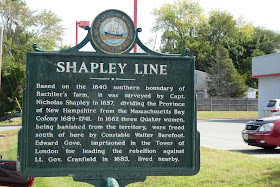Based on the 1640 southern boundary of
Bachiler’s farm, it was surveyed by Capt.
Nicholas Shapley in 1657, dividing the Province
Of New Hampshire from the Massachusetts Bay
Colony 1689 – 1741.
In 1662 three Quaker women,
Being banished from the territory, were freed
South of here by Constable Walter Barefoot.
Edward Gove, imprisoned in the Tower of
London for leading the rebellion against
Lt. Gov. Cranfield in 1683, lived nearby.
This roadside marker on the corner of Rt. 1 and Rocks Road
in Seabrook, New Hampshire has always intrigued me because it mentions the
BATCHELDER and GOVE families. I’ve blogged
about both families. I’m a descendant of
the founder of Hampton, New Hampshire Reverend Stephen Batchelder, and my
god-father is a descendant of Edward Gove. You can read about the BATCHELDER
family HERE (and HERE for all my BATCHELDER stories) , and you can read about
Edward Gove HERE.
In The History of the Town of Hampton, New
Hampshire, Volume 1, by Joseph Dow, on pages 135 – 136, is the story of
the Shapley line. This excerpt is from
the New Hampshire Provincial Papers, Volume 1, page 231:
“The bounds between the
two Townes menconed toward the sea is [are] to be upon a straight line
beginning at the middle of the Hampton Rivers mouth and Runing upwards to a
marked tree being and standing at the uppermost corner of the farm commonly called
Mr. Bachiler’s farme – the sayd line to Runne upon a west north west point of
the compasse nearest, and the said lyne being so Runne by both Townes & marked
out according as Capt. Shapleigh hath now draune the plat, wee Agree upon consideration
of all pleas, that the Towne of Salisbury shall have and enjoy thirty acres of
marsh on the north side of the said line towards Hampton at the lower end of
the said line to be layd out by both Townes and Adjoyning to the line; Also for
the upper line into the woods, wee determine that the line shall runne from the
marked tree before mentioned upon a west and by North line nearest according as
Captaine Shapleigh hath given in the line of the treading of Meremack River,
the which wee conclude to be the bounds between the said Townes unto their
utmost extent towards Haverill; wee doe further declare that what marsh the
Towne of Salisbury hath laid out to any of theire Inhabitants, that shall fall
within the lyne above menconed towards Hampton, they shall enjoy and so much
more shall make up the whole thirty acres, to be laid out belowe proprieties,
if there to be found, or els above, Joyning to the line, and this wee give as
our determination in the busines to us committed concerning the prmises.
Witnes our hands this
3d day of the five mo: 1657
John Appleton
Joseph Medcalf
Wm Bartholemew
Dan. Pearse”
At the time Joseph Dow published The History of The Town of
Hampton in 1892, the bound rock [marking the middle of the Hampton
River] and the Bachiler tree were still standing “all points are clearly
identified to this day.” [page
137]. Today these markers are both gone
or moved.
I’m not sure which member of the Rev. Stephen Batchelder’s
family is the “Mr. Bachiler” in the sign.
It could be the good Reverend himself.
I’m also not sure why they through in the story of the Quaker women and
Edward Gove on this road sign, either, other than the fact that these incidents
related to people who lived nearby.
Nicholas Shapley is often confused with Nicholas Shapleigh,
Merchant and Magistrate of Maine.
Nicholas Shapley of Charlestown, Massachusetts was a surveyor. There is no evidence he was related to the
Shapleigh family of the Piscataqua Region.
He lived from 1605 to his death in Charlestown on 15 February 1663. He left four children – Benjamin, Joseph,
Nicholas and Ann AKA Sarah wife of John Fosdick.
On the other hand, Nicholas Shapleigh the magistrate was born
in 1617 in Devonshire, England. He was one
of the wealthiest merchants in New England.
He was killed in 1682 when a mast fell off a vessel at the shipyard of John Diamond in Kittery. The inventory of his estate includes two Irish indentured
servants, and “4 Neagers 3 men one woman & one little Neager valued at 90
pound” [York Deeds Vol. V, Fol. 15 – 16].
You can read his will at this link (he had no children, he left his
estate to the children of his sister Katherine and brother Alexander): https://www.mainegenealogy.net/maine_wills.asp?source=probatecourtvol8&testator=NicholasShapleigh
My ancestor, Nathan Longfellow (1690 - 1731), who was the constable and tax collector for Hampton, New Hampshire. He was arrested by the town of Salisbury, Massachusetts for attempting to collect tax money for Hampton from residents of Massachusetts (on the "other" side of the Shapley line). See this blog post for the Surname Saturday LONGFELLOW sketch which mentions this incident about the Shapley Line: https://nutfieldgenealogy.blogspot.com/2018/11/surname-saturday-longfellow-of-newbury.html



No comments:
Post a Comment